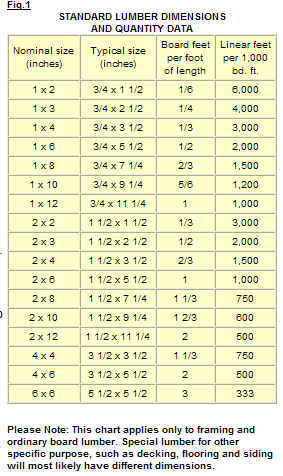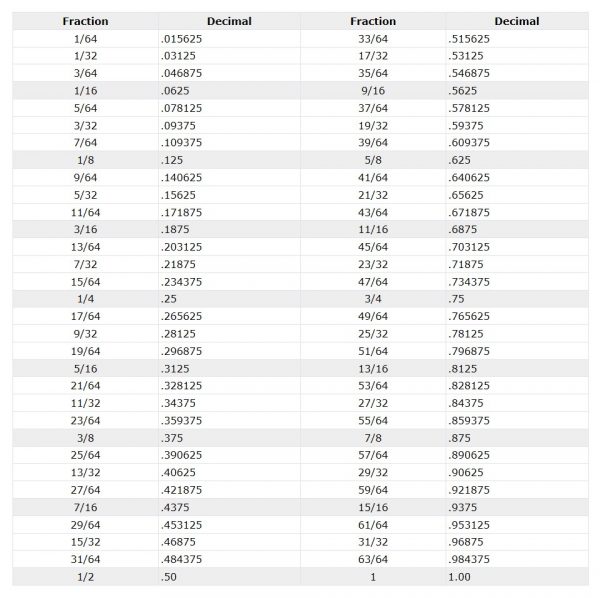Explaining Lumber Size Confusion:
So you bought your plans and see that a 2×4 stud is listed as 1.5″ x 3.5″….what’s up with that?
 Dimensional Lumber:
Dimensional Lumber:
Dimensional lumber sizes are called out in standardized dimensions of width and depth. The Nominal Size is what you ask for, the Typical Size is what you get. Dimensions are expressed in inches. Nominal size is specified in inches. Dried typical lumber size is always slightly smaller, but always by a standard difference.
Quick Example:
A common 2×4 construction stud (referred to as a “two by four”) is actually 1.5″ x 3.5″. This follows for most all lumber call-out names vs. finished dimensions. Refer to Figure 1.
Sheet Stock:
Plywood, paneling, and specialty lumber just use the real dimension as both its call-out name and real finished size; so 3/4 plywood is really 3/4″ or .75″ decimal. The charts below and right will help you understand both lumber dimensions and factional/decimal equivalents.
Rough Lumber Size:
Rough cut two by fours are usually the real 2″x 4″ in size. Commercially manufactured, kiln-dried construction lumber is finish-sized. Be assured, our plans use real finished sizes.
Call Out / Nominal Lumber Size :
This is the size of a piece of lumber before it is dressed and seasoned. Basically, it’s a commercial “trade name” used in name only for identification purposes. It is used to name a particular size piece of lumber, such as 2×4, 2×6, etc. This is what you will see in the plan parts descriptions.
Actual / Real / Typical Lumber Size :
Refers to minimum acceptable size after it has been dried, dressed, and seasoned. A nominal 2*4 can have a minimum real/typical size of 1.5″ x 3.5″. When referring to a specific piece of lumber, the nominal size is always used.
You’ll never hear a framing carpenter say “pass me another one and a half by three and a half”. The real-world measured size is what you really get. Just part of the lumber biz that you quickly learn to accept. Our cut & material lists always call out the nominal size. The actual plans however take into account the finished (typical) size.
Size Chart
Framing Lumber
Nominal Size Actual Size
2 x 2 – 1 ½ x 1½
2 x 3 – 1 ½ x 2 ½
2 x 4 – 1 ½ x 3 ½
2 x 6 – 1 ½ x 5 ½
2 x 8 – 1 ½ x 7 ¼
2 x 10 – 1 ½ x 9 ¼
2 x 12 – 1 ½ x 11 ¼
4 x 4 – 3 ½ x 3 ½
4 x 6 – 3 ½ x 5 ½
4 x 10 – 3 ½ x 9 ¼
6 x 6 – 5 ½ x 5 ½
Boards
Nominal Size Actual Size
1 x 2 – ¾ x 1 ½
1 x 3 – ¾ x 2 ½
1 x 4 – ¾ x 3 ½
1 x 5 – ¾ x 4 ½
1 x 6 – ¾ x 5 ½
1 x 8 – ¾ x 7 ¼
1 x 10 – ¾ x 9 ¼
1 x 12 – ¾ x 11 ¼
See the charts on lumber dimensions and fraction to decimal conversion above right.
[amazon_link asins=’B008AGWNII,B000BQKXLE’ template=’ProductCarousel’ store=’easyhomebarplans-20′ marketplace=’US’ link_id=’e38dc42f-a529-4847-a4b7-44459cdf3db1′]

